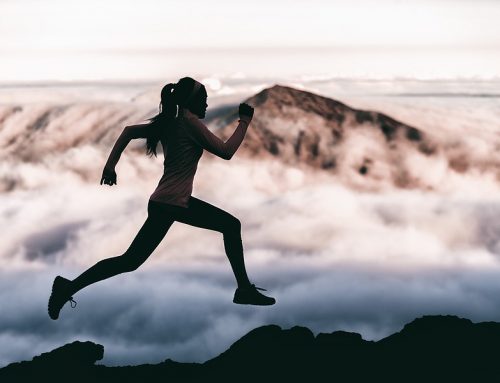This week, I’m running a special series of blog posts about motivation and fitness psychology. No aspect of sports and fitness psychology has gained more attention in the athletic community than mental rehearsal, also known as visualization. Almost ALL world-class athletes make extensive use of mental imagery to improve performance in their sport. However, the uses of visualization go far beyond mental rehearsal. Did you know that there are numerous different types of visualization and that you can use other types of imagery to help you build more muscle, burn more fat and get in better shape faster? It’s true, and research supports it…
Despite the fact that almost all Olympic champions and professional athletes make extensive use of visualization, this mental training technique is surprisingly overlooked. In fact, many people think visualization is a waste of time or even “woo-woo.”
To the contrary, not only is visualization one of the most widely accepted and proven techniques in all of sports psychology, it is supported by a vast data base of scientific research studies.
I was recently invited to speak on this subject on a teleseminar about fitness controversies and I’ve reprinted the transcript of a question I was asked about visualization in today’s post.
At the end, I’ve listed a bibliography of scientific references where you can learn more about the research if you are so inclined. If you are interested in improving your strength, athletic performance or physical appearance, you will find this fascinating…
QUESTION: Dr. Maxwell Maltz called it, “Entering the theatre of the mind.” It is one of the oldest methods for self improvement, visualization, that is. But a lot of people say they don’t think it will work and others say they want to try it but they don’t know how to visualize. They don’t know how to really put themselves in their mind’s theater and project a new future. They might be able to visualize their perfect day, but they’re stuck in the mundane minutia of the daily ritual, like “I’m up at 7:00. I have my coffee. I get in the car. I go to work. I’m back at 5:00. Then I go to the gym.” They don’t know how to visualize their future ideal body or see themselves performing in the gym at personal best levels because they’ve never experienced it before. What are some tips or tricks that you can give to people to help them better visualize their perfect body and life?
TOM VENUTO: Well, for sure, some people are more visual than others. We have dominant representational systems, which is the way we create internal experience in our mind. Some people are more auditory. Some people are more visual. Some people are much more feeling and more kinesthetic. That’s why some people find visualization to be a lot more natural than others. But everyone uses all three systems, so anyone can visualize.
A characteristic of your brain and your mind is that it thinks in pictures. So you’re already thinking in pictures. If I say, “Think about a big, bright, red apple right now.” You didn’t see the letters A-P-P-L-E in your mind. You saw the picture in your mind. It may not have been crystal clear for everybody, but the image did flash in your mind.So first of all, realize that not only can you make mental pictures, you’re already doing it. The more you practice visualization, the better you get at it. Practice is the key word there. I consider visualization a form of mental training, and just like physical training, if you want to get better at something you have to keep practicing it.
I like to talk about achieving a great physical condition as a combination of physical training and mental training. I talk a lot about mental training programs and part of the mental training is visualization. If you want to improve your visualization skills, you have to approach it as a real program. You’re going to be making pictures in your mind all throughout the day anyway. Every time you have a thought, you’re going to see that thought as a picture. But what you want to do is make it a formal process, just like you go to the gym and train.
You’ve set aside a time to go to the gym and train, right? Well, set aside a time for mental training. An ideal time to do it is first thing in the morning and also right before you go to sleep at night, because in both those cases, your unconscious mind is very primed and receptive to programming.
At one or both of those times, take a few deep breaths, get yourself in a deeply relaxed state and then begin to see pictures and play mental movies in your mind. As you go through that formal mental training process, where you’re actually doing a visualization training session, as opposed to doing it at random, you’ll start get better and better at it.
One trick, if you’re not that visual and you want to improve your visualization skills, is to use photos. One of the things that’s really popular now in the personal development community is a Vision Board. You clip out pictures of the goals you want to achieve. People are putting up a big bulletin board and snipping out pictures of everything in their life that they want: the cars, and homes, and the body that they want.
Even if this sounds like cheesy pop-psychology and self-helpish, trust me, it can be very effective. Cut out pictures of the physique that you want. Forget what you look like now. Forget what you think you can achieve. Dream big! Pick an image of your IDEAL future body. Put it on your board and project that in the theater of your mind.
I’m looking up at my bulletin board right now and I have pictures pasted all over my bulletin board of some of the top natural bodybuilders – champions who are far beyond my current physique. Every day, I’m putting that image in my mind, and looking at it every single day, it makes it easier for me to picture myself looking like that even though Ive never experienced it before.
You dont have to have already experienced it – This is using your creative faculties. this is using your imagination. I just picture MY head on top of that physique. When I close my eyes, I can see that body with fine detail and I imagine that it’s my body. I see the image and I feel the feelings of what it would be like to have that body. This is a type of goal or outcome visualization.
We have a lot of people in our Burn the Fat Inner Circle who have posted what they call Visualization Photos in our forums, where they cut out a photo of a body they wanted and they cut off a picture of their head and they pasted it onto the other body. We’ve got some people who did that in Photo Shop and it looks totally realistic. That’s extremely helpful in helping you become better at visualizing the end result of the body you want.
You can also use process visualization whre you mentally see yourself engaging in the action steps you’ll need to take to reach that goal. This is important, because it’s not just about the end results, it’s about the behaviors you need to take to get there.
For example, suppose you’ve always considered yourself not a morning person in the past. Well, visualize yourself getting up early and feeling great and energetic and jumping out of bed. Make that part of your visualization training. If you’ve had a historty of skipping workouts, visualize yourself getting in your car or walking down to the gym, going to the gym and actually going through the workout. And make it a great workout.
Obviously, t
here are some major potential benefits of using visualization to mentally rehearse yourself flawlessly executing sports skills or making a heavy lift. You’ll find stories about lifters seeing themselves making a record breaking lift throughout the sports, powerlifting and bodybuilding literature.
I’ve read some pretty amazing stories about the elite athletes, how they do their mental rehearsal. Judd Biasiotto is one that comes to immediately mind. He’s a sports psychologist, hypnotherapist, and motivational speaker…oh, and a world class powerlifter.
Dr Judd wrote a lot of great books that have unfortunately gone out of print. A few of them were, “Hypnotize Me and Make Me Great” “Search For Greatness” and “2001: A Sports Odyssey.” In those books, he talked about his visualization rituals. Here’s a guy who would visualize and do mental training 3 or 4 hours a day when preparing for a record-breaking lift attempt. I know this is an extreme example, but I point it out just to prove the point of how seriously some athletes take this mental programming process.
Did it work? well, you be the judge: This is a guy who at a body weight of 132 pounds, shocked the power-lifting world when he squatted 603 pounds. Do the math on that – its 4.5 times bodyweight! It’s just a staggering feat. It boggles the mind. Did I mention he nailed this lift after suffering what would have been a career-ending lower back injury for most “mere mortals?”
And this is a guy who trained his mind as much as his body – maybe MORE – and a big part of that for him was visualization and doing it seriously and doing it in a really structured and formal way.
Believe me, this only scratches the surface of the subject. My hope is that it was enough to get your attention, and enough to get you to add mental training and visualization right alongside your physical training.
There are other types of visualization that may have implications not only for aesthetic body transformations but also for your health.
My flagship program, Burn the fat, Feed the Muscle, is one of the few fat loss and body transformation programs that puts equal emphasis on mental training as physical training. To transform your body, you must transform your mind as well. Learn more about Burn the Fat, Feed the Muscle on the review page here: www.burnthefatblog.com/books
POSTSCRIPT If you’re still skeptical I can’t blame you, really. There IS some weird stuff out there in the personal improvement field. So, take a look at the research. Visualization is one of the most highly validated techniques in sports psychology…
Athletes’ use of exercise imagery during weight training. J Strength Cond Res. 2007 Nov;21(4):1077-81. Silbernagel MS, Short SE, Ross-Stewart LC.
Imagery is a cognitive process during which people use their minds to create (or recreate) experiences that are similar to real-life situations. This study examined how college athletes used imagery during weight training. Subjects were 295 Division I (n = 163) and Division II (n = 132) college student athletes (men: n = 138, women: n = 157) who participated in a weight training program as a requirement of their sport. They completed a slightly modified version of the “Weight Lifting Imagery Questionnaire.” Results showed that appearance imagery (i.e., images related to the attainment of a fit-looking body) was used and considered the most effective followed by technique imagery (i.e., images related to performing the skill and techniques correctly with good form) and energy imagery (i.e., images related to getting “psyched up” or feeling energized). Other variables that effected imagery use were gender, age, time of season, and levels of motivation. In addition, gender, previous imagery training, and level of motivation had an effect on the perceptions of imagery effectiveness. Confidence in the ability to image was associated with both imagery use and effectiveness, and imagery use and effectiveness were associated with confidence in the weight room. The findings support previous research in exercise imagery that appearance imagery is most used followed by technique and energy imagery and extend them in such a way that strength coaches have practical advice on how to use imagery in a positive way with their athletes.
misc references
Driskell, J.E., C. Copper, and A. Moran. Does mental practice enhance performance?. J. Appl. Psychol. 79:481–491. 1994.
Feltz, D.L., S.E. Short, and P.J. Sullivan. Self-Efficacy in Sport. Champaign, IL: Human Kinetics, 2008.
Gammage, K., C.R. Hall, and W. Rodgers. More about exercise imagery. Sport Psychol. 14:348–359. 2000.
Giacobbi, P.R., H.A. Hausenblas, E.A. Fallon, and C.R. Hall. Even more about exercise imagery: A grounded theory of exercise imagery. J. Appl. Sport Psychol. 15:160–175. 2003.
Hall, C.R. The motivational function of exercise imagery for participation in sport and exercise. In: Exercise Addiction: Motivation for Participation in Sport and Exercise. J. Annett, B. Cripps, and H. Steinberg, eds. Leicester, UK: British Psychological Society, 1995. pp. 15–21.
Hausenblas, H., C.R. Hall, W. Rodgers, and K. Munroe. Exercise imagery: Its nature and measurement. J. Appl. Sport Psychol. 11:171–180. 1999.
Martin, K.A., S.E. Moritz, and C.R. Hall. Imagery use in sport: A literature review and applied model. Sport Psychol. 13:245–268. 1999.
Moritz, S.E., C.R. Hall, K.A. Martin, and E.A. Vadocz. What are confident athletes imaging? An examination of image content. Sport Psychol. 10:171–179. 1996.
Munroe-Chandler, K. J., A. Kim, and K. Gammage. Using imagery to predict weightlifting dependency in men. Int. J. Mens Health. 3:129–139. 2004.
Paivio, A. Cognitive motivational functions of imagery in human performance. Can. J. Appl. Sport Sci. 10:22–28. 1985.
Rodgers, W.M., C.R. Hall, C.M. Blanchard, and K.J. Munroe. Prediction of obligatory exercise by exercise-related imagery. Psychol. Addict. Behav. 15:152–154. 2001.
Rodgers, W.M., K. Munroe, and C. Hall. Relations among exercise imagery, self-efficacy, exercise behavior, and intentions. Imagination Cogn. Pers. 21:55–65. 2001.
Short, S.E., J.M. Bruggeman, S.G. Engel, T.L. Marback, L.J. Wang, A. Willadsen, and M.W. Short. The effect of imagery function and imagery direction on self-efficacy and performance on a golf-putting task. Sport Psychol. 16:48–67. 2002.
Short, S.E., C.R. Hall, S.R. Engel, and C.R. Nigg. Exercise imagery and the stages of change. J. Ment. Imagery. 28:61–78. 2004.
Short, S.E., E.V. Monsma, and M.W. Short. Imagery direction of the Sport Imagery Questionnaire. J. Mental Imagery (In press).
Short, S.E., A. Tenute, and D.L. Feltz. Imagery use in sport: Mediational effects for self-efficacy. J. Sport Sci. 23:951–960. 2005.
White, A., and L. Hardy. An in-depth analysis of the uses of imagery by high-level slalom canoeists and artistic gymnasts. Sport Psychol. 12:387–403. 1998.
Wilson, P.M., W.M. Rodgers, C.R. Hall, and K.L. Gammage. Do autonomous exercise regulations underpin different types of exercise imagery?. J. Appl. Sport Psychol. 15:294–306. 2003.








No kidding that visualization is completely underrated. I recall a study many years ago that demonstrated that people who merely visualize an activity improve at a rate greater than those who actually physically engage in an activity. The study had 3 separate groups. One group actively practiced basketball free throws for an hour a day. Another group practiced free throws for a half hour each day. The third group visualized throwing successful free throws for an hour a day.At the conclusion of the study, the group that actually threw free throws for an hour a day showed the greatest improvement. The group that visualized the free throws showed more improvement than the group that actually practiced them for 30 minutes a day.The mind is a very complex organ that can be convinced that certain situations are real even when they haven’t actually manifested themselves in the physical. Physique transformation participants often end up looking remarkably like the photos they visualized for themselves.Woo-woo or not, it works. And doing what works makes sense.Great article, Tom!
Hi keith. thanks for your post. That sounds like the classic study that was published in research quarterly and was written up by maxwell maltz in PSYCHO-CYBERNETICS. great book – I highly recommend it.
I agree with your comments on visualization.Since taking up golf several years ago, one of the factors all coaches have stressed is to visualise the shot before you play it. That way you can “see” the shot you want to play and reinforces in your mind what you are going to do. Without it you are hitting “blind”.regardsKevin
Kevin, golfers might be more tuned-in to this than any other athletes!
“Αlways we must “create” the workout in our mind, before we go to gym !”
Hi Tom,Excellent article. One of the things that I have been working on is charging my emotions during my visualization sessions.Not only what will or does something look like, but how do I feel in this image? What powerful feelings come as a result of the image.It takes a lot of practice, but I think I am getting better at it.Thanks againJames
Thanks for the imagery lesson! I now imagine all sorts of non-physique images to help my visualization training like a picture of me getting out of bed with the alarm clock showing 5:00 am, a picture of me getting into the car with the street lamps still on, a picture of me on my sweaty smile after an intense workout session, and one with me playing with my kids and conquoring the playground with them!
TomI’ve had NLP training and ” fire walked ” with Tony Robbins in NY back in the day. Though as you mention most of us are Visual we should mention the Kinesthetic aspect and associated and disassociated techniques ( feeling yourself in your body or watching yourself ) Once people start ” just doing it ” I beliece the results will speak and people will start using it in every part of their lives. Thanks again.Rick
Rick. Right on. We could easily to another post just on associated v disassociated, and submodalities as well:Associated means, instead of just “watching a mental movie” of yourselve, you step into the picture and experience the experience with all the feelings and sensations and see what you would see as if through your own eyes during the experiencesubmodalites = experiment with making the pictures, bigger, brighter, more colorful and so on
James and Rick make very good points – that visualization takes PRACTICE and that you must put it into practice before you truly understand it. We can talk about it all day, but it’s only valuable if you try it for yourself.I recently used visualization techniques to prep for my first official clubbell competition. I saw myself using perfect technique for every single repetition, and that’s exactly what was the result!
“Yes, seeing it before it happens is 95% of the battle.thanks Tom!”
Hi Tom, I do have trouble with visualizing and the photo idea works best for me.Never heard of woo-woo but I guessed that’s what it meant. I wonder if EFT would be classified as woo-woo? Probably – but I really enjoy it and feel very relaxed afterwards.
One of the biggest problems I have just discovered with my attempts at visualization is that I still see myself as I was 10 years ago when I was fit. I have avoided looking at myself now – I’m currently at the highest weight I’ve ever been. Therefore, there is no real reason to motivate myself to change. I have finally figured out that I need to take a better look at myself as I truly am now.
It’s amazing how your mind might be programmed to lie to you about your appearance, your abilities, your attitude, your personality. It’s sometimes very hard to not allow your mind to “get away with” the lies. Being honest with yourself is not easy. After reading several motivational articles today posted by Tom, I’m going to try very hard to be more honest with myself so that the techniques I’ve just read will actually work!